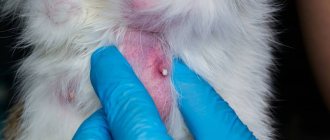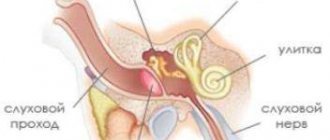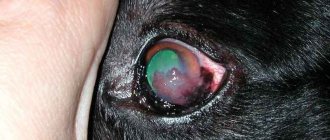Infectious mycoplasmosis in dogs is provoked by single-celled polymorphic organisms that are difficult to diagnose. Asymptomatic carriage can continue for years, and pathogens will manifest themselves when the animal’s immunity decreases. A dangerous disease often affects various organs; in advanced cases, it can be identified by external signs.
What is it and types
Mycoplasmas are single-celled organisms that do not have a cell wall. A special feature of these bacteria is that they contain both DNA and RNA. There is no dispute. Under a microscope, one can be surprised by a completely different shape in one type of mycoplasma: spherical, ellipsoid, disc-shaped, rod-shaped, filamentous, and also branching. The size of these microorganisms varies from 0.2 to 0.3 microns.
Mycoplasmas are quite specific microorganisms; due to the lack of a cell wall, they are very plastic, sensitive to sudden changes in osmotic pressure, detergent, alcohol, specific antibodies and complement.
Previously, scientists believed that mycoplasmas parasitized humans and animals; later it turned out that these microorganisms are more common in the environment, for example, they are found in soil, coal, in some hot springs, in the form of saprophytes and symbiotic forms.
At the moment, only 14 types of mycoplasmas have been described: Mycoplasma cynos, Mycoplasma canis, Mycoplasma haemocanis, Mycoplasma haematoparvum, Mycoplasma bovigenitalium, Mycoplasma edwardii, Mycoplasma felimirutum, Mycoplasma gateae, Mycoplasma spumans, Mycoplasma haemobos, Mycoplasma haemominutum, Mycoplasma felis, My coplasma molare, mycoplasma maculosum , Mycoplasma opalescens, Ureaplasma canigeritalium, Acholeplasma laidfawii.
Mycoplasmas are normally isolated from more than 80% of dogs on the mucous membrane of the oral and nasal cavities, prepuce, and vagina. Bacteria do not always show their pathogenicity, so an animal may not suffer from mycoplasmosis, but be its carrier, while feeling great.
A dangerous, or rather specific, microorganism for dogs is Mycoplasma canis. It is this mycoplasma that causes disease in dogs.
Fighting methods
More often the disease affects small puppies and older pets. Sometimes mycoplasmosis appears after illness and surgery. The disease continues against the background of bacterial or viral contamination of the mucous membranes.
In the washings of dogs with mycoplasmosis, intracellular microorganisms that cause chlamydia are also detected. Both types of illnesses are characterized by a duration of course, hidden symptoms and activity during a decrease in immunity. A side effect of mycoplasmas is that they weaken the dog’s defenses and thereby attract other infectious agents. Sometimes it is difficult to immediately determine the cause of the disease, since it may be the original pathogen or an attached secondary microflora.
Diagnostic methods
A full examination of the animal is carried out to make a conclusion and determine the stage at which the disease is located. Diagnosis is carried out using various laboratory testing methods.
The most effective methods:
- RSK - test of the immune complex binding reaction.
- ELISA is an enzyme-linked immunosorbent assay for the quantitative and qualitative composition of low-molecular compounds.
- RNHA - passive hemagglutination test to determine antibodies in serum.
- PCR is a polymerase chain reaction method for studying the accumulation of DNA parts in the taken material.
False-negative test results can occur if the pathogen has recently entered the dog’s body or the testing technology has been violated. Laboratory methods are complex studies and require the organization of a special environment for experiments.
The following samples are taken from the pet:
- urine and blood analysis;
- smears for conjunctivitis;
- washings from the bronchi, trachea, nose;
- smears from the mucous layers of the genital organs;
- skin scraping.
External manifestations of the disease are not always noticeable, so only a veterinarian in the clinic can give a reliable conclusion. As a result of the examination, the level of mycoplasmas and the degree of their activity are revealed. Bacteriological culture of urine and blood is also necessary. The presence of agents in the urinary system and the reaction of the pathogen to the action of antibiotics are checked. An effective study is carried out by specialists from the scientific and clinical center on Orekhovoy Boulevard in Moscow (Shilovskaya metro station), as well as in the town of Kotelniki near Moscow on Pokrovsky Proezd.
Therapeutic effect
Treatment of pathological disorders is a complex scheme. A long-term event requires patience and endurance from the owner and is based on the use of antibacterial drugs and drugs to relieve symptoms. A sick animal is isolated if there are other four-legged animals in the house or kennel.
Mycoplasmas in dogs are sensitive to antibiotics of the tetracycline group, which suppress the production of non-nuclear organisms. If there is no result, then the treatment is adjusted, the medicine is changed.
The veterinarian uses medications:
- usually prescribes two types of antibiotics at the same time, Doxycycline, Tylosin, Levomycetin, Macropen, Erythromycin work well;
- prescribes hepatoprotectors to protect the liver from the destructive effects of medications;
- Prescribes immunostimulants to increase the body's resistance;
- Prescribes local ointments and other medications to relieve painful symptoms, uses painkillers and anti-inflammatory drugs.
A repeated examination is required during the period of therapeutic treatment to determine the effectiveness of the drugs. Pets need to be treated for 10 to 21 days. The antibiotic is selected taking into account the principle of its effect, for example, drugs that destroy the cell membrane are not used. Mycoplasmas do not have such a wall, so therapy will not lead to a positive outcome.
Recovery period
Sometimes mycoplasmas that have been suppressed by the immune system remain in the body, even if tests show the dog is completely cured. Therapy continues for the full period prescribed by the doctor, despite a significant improvement in the pet’s condition. In recent days, drugs have been used to restore immunity, which will help in the fight against residual microorganisms.
Due to the problem of decreased resistance, caution is required when interacting with other animals. A dog can become infected with hepatitis, canine distemper, and get enteritis. These conditions are classified as complex and often result in the death of the pet.
A special diet prescribed by a veterinarian is required. This is due to the fact that after antiparasitic treatment, the intestinal microflora may be disrupted. The breakdown of elements in the liver disrupts its functioning, so you should not overload the organ with the wrong foods. Recovered pets are usually sterilized.
Causes of the disease and routes of transmission of mycoplasmosis in dogs
It was mentioned above that mycoplasmas are part of the normal microflora of an animal, so the disease will manifest itself only if the immune system is weakened.
When an opportunistic pathogen enters the body of an animal, the mycoplasma interacts with its cell, then the microorganism feeds at the expense of the host, in our case the dog. As a result of living in the body, bacteria produce hydrogen peroxide and hydrogen nitride. The release of these chemicals disrupts the proper functioning of a healthy cell.
Not only dogs can suffer from mycoplasmosis. Humans, plants, and insects are also susceptible to this disease.
Ways of infection with mycoplasmosis:
- aerosol (airborne);
- contact (sexual, direct contact or household contact);
- nutritional (food and water);
- blood contact (blood transfusion route, transmissible route).
Mycoplasmas are not transmitted transplacentally, but puppies are infected in the first days of life through mother's milk.
Mycoplasma canis is not always contagious. If your pet has a strong immune system and does not have cancer or chronic diseases, then pathology will not appear. If the body is weakened due to: viral, bacterial, parasitic, oncological diseases, pregnancy, stress and unfavorable living conditions, then the following picture may occur:
- conjunctivitis;
- damage to the respiratory system;
- diseases of the musculoskeletal system;
- postpartum diseases in bitches;
- diseases of the genitourinary system;
- pathological changes in the liver and kidneys.
If a pregnant dog gets sick with mycoplasmosis, then one should expect sad consequences: infertility, stillbirth, miscarriage, birth of diseased fetuses.
The main question that owners of sick animals ask is whether it is possible to get infected from a dog, and can mycoplasmosis be transmitted to humans?
It is believed that mycoplasmosis in humans and dogs is caused by different types of pathogens (mycoplasmas), so it is impossible for a person to become infected from a dog. But when in contact with sick dogs, you should follow the rules of personal hygiene.
Mycoplasma hominis (mycoplasma hominis) is not found in dogs; this species is characteristic only of humans.
Prevention
There are no vaccinations against mycoplasmosis, so only the owner’s attentive attitude to his health and proper care can protect his pet. It is difficult to determine mycoplasmosis, since the pathology has a vague clinical picture, treatment takes a long time, so it is better to strengthen the pet’s immune system and monitor its health. If you do not allow your dog to pick up food on the street and come into contact with stray dogs, undergo timely examinations by a veterinarian and get tested for mycoplasmosis, and vaccinate the animal according to the vaccination schedule, you can avoid the dangerous consequences of infection.
Share this article on social networks
Symptoms in dogs
It is impossible to make a diagnosis of “mycoplasmosis” without laboratory tests, since there are no characteristic symptoms for this disease, all symptoms are vague and can be consistent with a number of other diseases.
But the owner should contact a veterinarian if these symptoms appear:
- Conjunctivitis (the most common manifestation of mycoplasmosis in dogs is eye damage; the conjunctiva of the eye is red and inflamed, and lacrimation is observed).
- Respiratory diseases (cough, sneezing, rhinitis, runny nose).
- Diseases of the genitourinary system (cystitis, urethritis, nephritis, prostatitis, vaginitis in bitches, stillbirth, abortion, etc.).
- Lameness, unnatural movements, apathy, general depression.
- Abscesses, dermatitis.
- Fever, lack of appetite, vomiting, diarrhea.
Mycoplasmas are of great importance as a secondary pathogenic agent.
Mycoplasmosis should be differentiated from chlamydia; the correct diagnosis determines the correctness of the prescribed treatment.
Preventive measures
Healthy and active dogs rarely get sick with mycoplasmosis, so you should organize a balanced diet and give feasible physical activity. Ensuring proper living conditions involves selecting nutritious food products and regularly walking dogs in the fresh air. The pet is provided with a certain temperature regime and a place to rest without drafts.
It is important to guard against contact with infected four-legged animals or those that have symptoms, but the owners do not examine them. Females and males who have pathogens detected in their bodies are not allowed to breed.
The owner must supervise the animal during a walk so that the pet does not pick up garbage, various scraps, and other objects. It is recommended to conduct a course of training, since young and untrained dogs are guilty of such collecting.
There is no vaccine against mycoplasmosis, but compliance with the schedule of other mandatory vaccinations and regular examinations in the veterinarian's office are required. Regular treatment is done for internal and external parasites, such as worms, fleas and ticks.
Diagnostics
Diagnosis of mycoplasmosis is impossible only by clinical signs, even for the most experienced veterinarian. This disease can only be identified using laboratory diagnostic methods.
- The main diagnostic method is PCR, which allows you to identify the pathogen.
- RIF (immunofluorescence reaction) - detection of pathogen antigens.
- ELISA (enzyme-linked immunosorbent assay) – detection of pathogen antibodies.
- Wash from the trachea, wash from the bronchus, smears.
The detection of mycoplasmas does not mean that the animal has mycoplasmosis, since healthy animals normally have mycoplasmas.
How is mycoplasmosis treated?
In dogs, the treatment regimen is complicated by the fact that self-infection constantly occurs. It is unrealistic to maintain sterility for the entire duration of therapy. In addition, it is important to correctly establish what triggered the development of mycoplasmas. Perhaps there is an underlying disease that preceded mycoplasmosis.
In any case, it is necessary to influence microorganisms with antibiotics. There is also a nuance here - the relationship of mycoplasmas to antibiotics is determined by their lack of a cell wall - they are resistant to all drugs that affect the proteins of the bacterial cell wall.
The most effective classes of antibacterial drugs are:
- tetracycline series (doxycycline);
- macrolides (azithromycin);
- aminoglycosides (neomycin);
- chloramphenicols (chloramphenicol).
Antibiotics are prescribed individually for a course of at least 14 days. Typically, antibiotic therapy lasts 21 days. In severe cases, a combination of several drugs is possible, but this is only at the discretion of the veterinarian.
In addition, it is possible to use local drugs:
- eye drops – floxal, tsiprolet, tsiprovet;
- erythromycin ointments or suppositories.
Often 3-5 days before starting antibiotics, immunotherapy is performed. These can be injections (Immunofan, Roncoleukin), drops (interferons), rectal suppositories (Viferon).
Treatment
Treatment is prescribed by a specialist; for mycoplasmosis it is quite long. They are treated mainly with antibiotics: tylosin, erythromycin, doxycycline, minocycline, chloramphenicol and others (broad-spectrum antibiotics are not suitable!).
Since mycoplasmas quickly adapt to the drug, two antibiotics are prescribed at once for more effective treatment. But to keep the liver healthy, hepatoprotectors are prescribed.
To maintain the body, immunostimulants and modulators are used.
For symptomatic therapy, drops and ointments for the eyes, anti-inflammatory, painkillers, etc. are prescribed (individually for each pet).
Do not self-medicate; if you notice any deviations, consult a specialist!
Possible complications
The course of medications and treatment methods must be confirmed by the specialist who made the diagnosis. If the owner independently decides to cure the animal, then there is a high probability that the multiplying bacteria will become immune to drugs and antibiotics. In addition, many drugs negatively affect liver function; without the right stimulating medications, a dog can die from liver failure.
This disease torments the animal's immune system, so it is important to be especially careful during the treatment and recovery period. A pet can become infected with canine distemper, enteritis, and hepatitis. These infectious diseases are much more difficult to treat and are often fatal.
Even with comprehensive proper treatment, mycoplasmas remain in the dog’s blood. Therefore, the animal remains infectious to others. It is important to prevent a dog that has had mycoplasmosis from reproducing. With strong surges in the functioning of the immune system, relapses can occur.
Briefly about the main thing
- Infection of a person from a dog does not occur due to different types of pathogen.
- Mycoplasma canis is the causative agent of mycoplasmosis in dogs.
- Normally, mycoplasmas are present in most dogs, but do not cause disease.
- Infection occurs by airborne droplets, contact and nutritional routes.
- Treatment with antibiotics, the duration of therapy depends on the stage of the disease.
- The symptoms of mycoplasmosis are nonspecific, but ophthalmic lesions are more common.
Clinical picture
Until the necessary diagnostic tests are carried out, it is not possible to determine mycoplasma infection. The pathology is manifested by symptoms inherent in a specific disease caused by damage to a specific organ by Mycoplasma cynos.
The owner should be alert to the following signs:
- redness and suppuration of the eyes, increased lacrimation;
- runny nose;
- stomach pain, diarrhea, or constipation;
- problems with urination;
- nausea, vomiting;
- high temperature, fever;
- pain and swelling of the joints, lameness;
- poor appetite or lack thereof;
- low mobility, apathy;
- anemia;
- skin rashes (dermatitis, eczema, dermatosis).
The blurred clinical picture and similarity with other pathologies makes diagnosis difficult.











